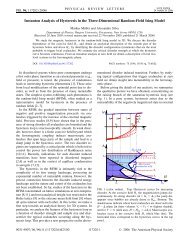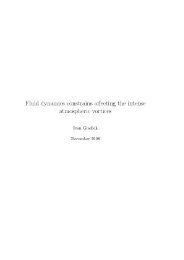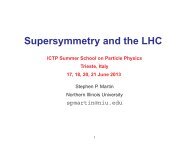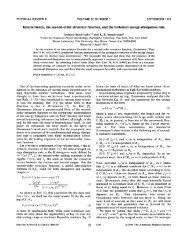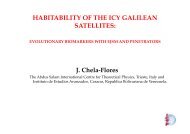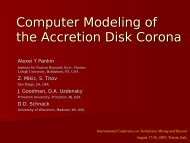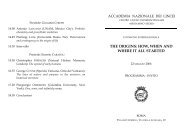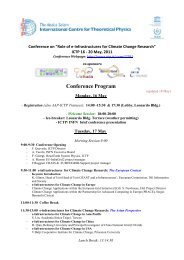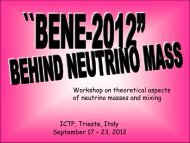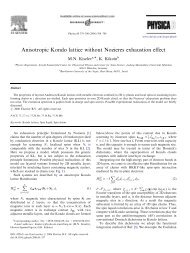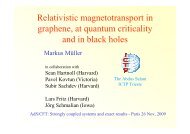Moisture and Temperatures in the Atmosphere - ICTP
Moisture and Temperatures in the Atmosphere - ICTP
Moisture and Temperatures in the Atmosphere - ICTP
You also want an ePaper? Increase the reach of your titles
YUMPU automatically turns print PDFs into web optimized ePapers that Google loves.
<strong>Temperatures</strong> <strong>in</strong> atmosphere<br />
Temperature is a fundamental variable for <strong>the</strong> description <strong>and</strong> prediction of atmospheric<br />
processes because it gives <strong>in</strong>formation concern<strong>in</strong>g <strong>the</strong> direction <strong>in</strong> which <strong>the</strong> exchanges of <strong>the</strong>rmal<br />
energy take place. But <strong>the</strong> temperature of an air-mass or better of an air parcel can change<br />
accord<strong>in</strong>gly to its evolution, it is useful to <strong>in</strong>troduce several “temperatures” that are not real <strong>in</strong> <strong>the</strong><br />
sense that <strong>the</strong>y can be currently measured by a simple <strong>the</strong>rmometer, but <strong>the</strong>y are go<strong>in</strong>g to be reached<br />
when an air parcel is subject to a well def<strong>in</strong>ed transformation. For this reason <strong>the</strong>se temperatures are<br />
function of <strong>the</strong> current air parcel properties (e.g. fraction of water vapor, ...) <strong>and</strong> of <strong>the</strong><br />
transformation (e.g., isobaric, adiabatic, ...).<br />
Dew po<strong>in</strong>t temperature<br />
Dew temperature is def<strong>in</strong>ed as <strong>the</strong> temperature reached by an air-mass when it is cooled<br />
isobarically, keep<strong>in</strong>g constant its content of water vapor (e.g, de/dt=0 ), up to <strong>the</strong> level <strong>in</strong> which <strong>the</strong><br />
condensation of water vapor takes place. This temperature can be computed us<strong>in</strong>g <strong>the</strong> Clausius-<br />
Clapeyron equation<br />
des 1<br />
=<br />
dT T<br />
l v<br />
ν v−ν w<br />
where es is <strong>the</strong> saturation vapor pressure, T <strong>the</strong> absolute temperature, lv <strong>the</strong> latent heat of<br />
condensation per unit mass <strong>and</strong> νv <strong>and</strong> νw are respectively <strong>the</strong> specific volume (<strong>in</strong>verse of density) of<br />
water vapor <strong>and</strong> liquid water.<br />
The above equation can be simplified, for atmospheric purposes, keep<strong>in</strong>g <strong>in</strong> m<strong>in</strong>d that <strong>the</strong> specific<br />
volume of water is usually very small compared to <strong>the</strong> specific volume of vapour (i.e., <strong>the</strong> density of<br />
liquid water is usually higher than water vapor density) <strong>the</strong>n we can write<br />
de s<br />
dT ≈ l V<br />
T v V<br />
approximat<strong>in</strong>g <strong>the</strong> behavior of water vapor with an ideal gas we can write e s = ρ v R v T that, when<br />
<strong>in</strong>serted <strong>in</strong>to <strong>the</strong> above equation, becomes<br />
de s<br />
dT ≈ l V e s<br />
R V T 2<br />
This equation, when <strong>in</strong>tegrated, gives <strong>the</strong> follow<strong>in</strong>g result<br />
e s<br />
e ref<br />
≈ e<br />
l V<br />
R V T ref<br />
l V<br />
R V T<br />
e<br />
that can be written <strong>in</strong> <strong>the</strong> follow<strong>in</strong>g, more readable, form<br />
e s ≈ Ae − l V<br />
R V T



